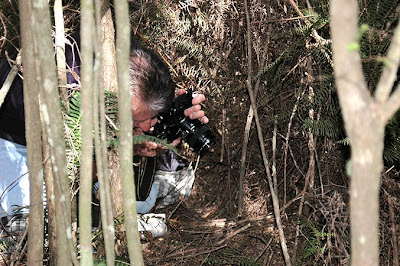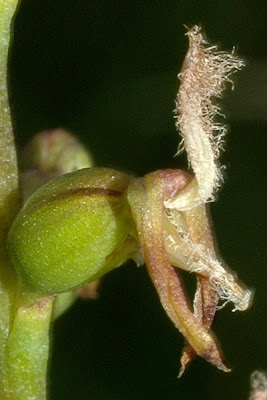As Colin and Mischa are southerners, Alan and I showed them a few flowering specimens of Diplodium pulchellum, the Illawarra Greenhood. This is one of the few genuinely "endemic" local Orchids, so I knew it would be a good one to start with, as they could never see this plant in Victoria. I was able to show them some in a typical habitat, near a waterfall, and also several specimens (long past their prime, but still identifiable) growing in a muddy creekbed, in really dense dark shade, under Melaleuca scrub. Alan was interested to see this species in this non-typical habitat.
 Next we went into another patch of dense Melaleuca scrub, also in a creekbed, to see the green form of the Chiloglottis sylvestris, which I wrote about two days ago. Because I knew these plants were unusual, and knowing Colin and Mischa would be coming up today, I had marked the general location of these plants. I found my tag, but could not see the plants. I was very despondent. Had a passing Swamp Wallaby paused for lunch, and eaten these plant? Surely I (or they) could not be that unlucky? Anyway, after searching high and low, with no success, we pushed on, and 20 metres further along the creekbed, Misca suddenly called out: "There's some leaves here, and green flowers". Sure enough Mischa had rediscovered my plant from two days ago. And, yes I had placed a second marker there, but it was so well disguised, we found the plants before I noticed the marker! I don't like leaving markers*** anyway! But, I felt pleased we had found these unusual plants - and at least my honour was restored!
Next we went into another patch of dense Melaleuca scrub, also in a creekbed, to see the green form of the Chiloglottis sylvestris, which I wrote about two days ago. Because I knew these plants were unusual, and knowing Colin and Mischa would be coming up today, I had marked the general location of these plants. I found my tag, but could not see the plants. I was very despondent. Had a passing Swamp Wallaby paused for lunch, and eaten these plant? Surely I (or they) could not be that unlucky? Anyway, after searching high and low, with no success, we pushed on, and 20 metres further along the creekbed, Misca suddenly called out: "There's some leaves here, and green flowers". Sure enough Mischa had rediscovered my plant from two days ago. And, yes I had placed a second marker there, but it was so well disguised, we found the plants before I noticed the marker! I don't like leaving markers*** anyway! But, I felt pleased we had found these unusual plants - and at least my honour was restored!Mischa lining up a photo of the
Green variety of Chiloglottis
Green variety of Chiloglottis

Mischa, not content with having found my plants, went on to find a number of other specimens of these green form of the Chiloglottis sylvestris. These latter plants were deeply hidden under Coral Fern and other ferns, still within the thicket.
Having had a successful hour or so, we returned to Robertson for lunch at Three Creeks Cafe, where Bernie joined us. Then we went to Tourist Road. I saw a Swamp Wallaby beside the road near Mount Murray, and a very fine Copperhead Snake quickly turned and cleared off the road, also in the wet forest, on the eastern end of Tourist Road. Colin and Mischa, in the car behind saw the snake, as I swerved to dodge it (there was no other traffic).
We then stopped briefly at Butler's Swamp, and Colin was very impressed with our tall and strongly coloured "Ladies Tresses Orchids" (Spiranthes australis). We also found a few Horned Orchids, (Orthoceras strictum) (which I had not previously seen in this location.)
There were also a few flowers of Small Tongue Orchids amongst the bark litter, under some Scribbly Gums.
Kirkland Road revealed some nice specimens of Chiloglottis seminuda, and also C. reflexa. I have written about these plants previously.
Colin is using a 10 power hand lens
to inspect a Ch. seminuda flower
Mischa is waiting to photgraph the flower.
to inspect a Ch. seminuda flower
Mischa is waiting to photgraph the flower.

We adjourned towards the western end of Tourist Road, and within moments of getting out of our cars we saw two different species of Corunastylis, the "Tiny Greenhoods" (Speculantha sp. aff. parviflora) I have written about these plants recently. There were several Greenhoods, growing in dry grass, beside the road. As yet I have not worked out what species these are.
There were many, many Parsons' Bands Orchids (Eriochilus cucullatus) growing here, as well.
We examined closely some specimens of Corunastylis apostasioides (I believe it is this species).
Click on the photo to enlarge it.

It is certainly very different from the other Corunastylis I have shown you recently. Indeed the flowers of this species are so tiny, it looks like a little bit of "fluff" on the end of the somewhat swollen ovaries which these relatively tall Corunastylis Orchids have. The other species of Corunastylis growing here has a regular sized flower for this genus, with lateral sepals spreading about 15 mm wide. The C. apostasioides flowers (if that's what they are) do not spread their lateral sepals at all - instead they lie tightly beside the dorsal sepal.
As weird Orchids go, this one is pretty "out there".
The "Labellum" is fully reflexed, and very hairy.
The Dorsal Sepal is in the centre of the flower, and also very hairy.
It is much smaller than the labellum.
The two lateral sepals lie close beside the dorsal sepal.
They do not spread wide, as in the neighbouring Corunastylis species.
The "Labellum" is fully reflexed, and very hairy.
The Dorsal Sepal is in the centre of the flower, and also very hairy.
It is much smaller than the labellum.
The two lateral sepals lie close beside the dorsal sepal.
They do not spread wide, as in the neighbouring Corunastylis species.
 Finally, we adjourned to The Gib, to examine some very nice specimens of Diplodium coccinum, and also some nice tall specimens of Acianthus exsertus
Finally, we adjourned to The Gib, to examine some very nice specimens of Diplodium coccinum, and also some nice tall specimens of Acianthus exsertus*** The temporary markers have now been removed!

No comments:
Post a Comment